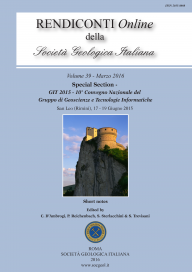
Assessment of aquifers groundwater storage for the mitigation of climate change effects
Luca Alberti (a), Martino Cantone (a), Loris Colombo (a), Gabriele Oberto (b) & Ivana La Licata (a)
(a) Dipartimento di Ingegneria Civile e Ambientale, Politecnico di Milano, Piazza Leonardo da Vinci, 32, 20133, Milan, Italy. E-mail: luca.alberti@polimi.it
(b) Hydroinformatics Lab, Politecnico di Milano, Polo Territoriale di Como, via Valleggio, 11, 22100, Como, Italy. E-mail: gabriele.oberto@polimi.it
Volume: 39/2016
Pages: 89-92
Abstract
In the coming decades, the effects of expected climate change will affect key aspects of our society including quantity and quality of available water resources. It is believed that water resources will play a growing important role in Europe and in particular in the countries south of the Alps, where climate change could hit harder (EEA, 2014). Without appropriate interventions, water will turn from a good hearty undervalued to a scarce and precious resource, whose distribution will be less and less equitable, resulting in growing conflicts for its use. As already recognized by the European directives (2000/60/EC and 2006/118/EC), the theme of quantitative management of water resources is therefore a strategic issue that can allow the reduction of the risks and costs associated with climate change. Integrated management of both surface and groundwater for sustainable use nowadays represents more and more a key concern in environmental policies and water management. The goal of this work is to assess the effects on groundwater storage of a new management of irrigation waters.
The highly variable availability of water resources during the hydrological season could be particularly troublesome in the management of irrigation systems, since they need water in seasons (spring-summer) when usually its availability has a depletion. Storage of groundwater in aquifers in colder seasons could be used to soften irrigation systems water deficit in drier ones. Specifically, the practice of "winter irrigation", i.e. the use of the main irrigation channels to recharge aquifers during the colder seasons, could increase water resource availability for irrigation during the drier growing seasons.
A pilot groundwater flow transient model (MODFLOW2000, Harbaugh et al., 2000) with a domain of about 255 km2 was implemented in the north zone of Lodi Province, including a large part of the Consorzio Muzza irrigation district. The model was then run to estimate change in groundwater resource availability in two main scenarios: in the first scenario the storage in the shallow aquifer was computed in the colder period (October–March), when irrigation is not occurring; for this case, it was used measured monthly rainfall, average temperature for the period 2004-2013 (representing actual climate conditions) and an estimations of water volume used for irrigation. In the second scenario, an integrated management approach of irrigation and groundwater was tested, adopting "winter irrigation". Both scenarios want to assess if water storage in aquifers in colder periods could represent an additional water volume useful to mitigate possible climate changes effects on crops.
Keywords
Get Full Text